
Playbill for concerts by the Sixth Front-Line Brigade. 1943
Having been evacuated to Molotov, the Kirov Theatre regularly gave special concerts for companies in the Molotov Region as well as sending concert ensembles to the front. From 1942 these orchestras were numbered. The First Front-Line Brigade set off for the front on 15 June 1942 and the Sixth in February 1943.
On its return the theatre’s in-house newspaper reported that “The brigade was formed in connection with the 25th anniversary of the Red Army and provided cultural entertainment for ships of the Red-Bannered Baltic Fleet and units of the Volkhov Front, giving a total of forty-three concerts.”

The Sixth Front-Line Brigade of the Kirov Theatre. 1943
Top row, L-R: violist Arbam Edelman, violinist Donat Shevalin, ballet soloists Anna Ulitina and Alexandra Blatova, dancer Valery Bogdanov, cellist Sarra Brog, violinist Boris Sandovsky and cellist Mikhail Cherkasov. Bottom row, L-R: opera soloists Vasily Tikhy and Anastasia Bazarova, ballerina Tatiana Vecheslova, Boris Freidkov (bass), Agnia Lazovskaya (soprano) and dancers Vladimir Fidler and Andrei Lopukhov
Tatiana Vecheslova recalled: “We were told that on 23 February 1943 we had to be on the Leningrad Front, and before that we had to go to Leningrad for two weeks to entertain the ships’ crews and army units. We were given uniforms of sheepskin coats, caps with ear-flaps, quilted jackets, trousers and soldier’s shirts. I looked more comical than inspiring. <...> On 25 January we were in Moscow. There we were given documents and permission to travel to Leningrad. Since the siege started we were the first brigade to enter the city. We were only able to do so using the ice road – the Road of Life.” *
*T. Vecheslova. I Am a Ballerina. Leningrad-Moscow: Iskusstvo, 1964. P. 159

The Road of Life. Photograph by Rafail Mazelev
“We gave concerts in clubs and on ships. Classical dance was rarely performed. Sometimes, when circumstances allowed, I danced Nune’s variation and, together with Fidler, Dolls to music by Lyadov. Essentially my repertoire was reduced to the Russian Dance from the ballet The Little Humpbacked Horse which I performed with Andrei Lopukhov and the Lezghinka – concerts normally ended with that.” *
*T. Vecheslova. I Am a Ballerina. Leningrad-Moscow: Iskusstvo, 1964. P. 159

The Sixth Front-Line Brigade on the Volkhov Front. March 1943
“The fieldtrip was also memorable; not long before that we had met the troops of the Volkhov and Leningrad Fronts when breaking through the Siege of Leningrad. In the field there was a dug-out where we gave a concert. However Fidler never broke his legs dancing his hopak one can only imagine. Most remarkable was the lighting: on the small stage on each side there were soldiers who, throughout the entire concert, held missile cases with burning kerosene.” *
The photograph clearly shows the performers each sitting next to the soldiers. It was not by chance that Boris Freidkov was always in the centre of group photographs – he was the secretary of the theatre’s Party Organisation. On his right is the ballerina Tatiana Vecheslova, Chair of the Shop Committee.
*T. Vecheslova. I Am a Ballerina. Leningrad-Moscow: Iskusstvo, 1964. P. 176

Agnia Lazovskaya. Concert on the Volkhov Front. March 1943
It may seem surprising that in the snow-covered forest the singer Agnia Lazovskaya stood in slippers and a light costume. Even in the bitter frosts the performers went on the improvised “stage” not in sheepskins and hats with ear-flaps (their colleagues had these at the ready just off-stage) but in evening dress.


Georgy Tsorn. Set sketches for The Queen of Spades. 1943
One major event for the people of Leningrad was a new stage version of the opera The Queen of Spades mounted by the City Theatre. The production was designed by Georgy Tsorn, the husband of singer Nadezhda Velter who staged the opera. He designed almost every production of the Siege Theatre.

Playbill for the opera The Queen of Spades. 1943
The September playbill listed the twenty-first and twenty-second performances. The premiere had taken place on 15 March 1943 at the Comedy Theatre. The production was staged by Nadezhda Velter who had sung the role of the Countess in the famous production of The Queen of Spades by Meyerhold at the Maly State Opera Theatre in 1935. At the Siege Theatre she performed this role in turns with Sofia Preobrazhenskaya.

Sofia Preobrazhenskaya. 1940s
“The whole performance is imprinted on my memory like a film reel,” recalled Galina Vishnevskaya who was then sixteen, and she first heard The Queen of Spades at that theatre. “Even now I can see before me the emaciated Hermann, Liza with her bare shoulders – blue and skinny like a skeleton – covered with a thick layer of white powder; I remember the great Sofia Preobrazhenskaya as the Countess (never again in my life will I hear such a dramatic mezzo-soprano) – that was when she was at the height of her powers.
“When they sang the steam came out of their mouths. The emotion and amazement I felt there was not just the enjoyment of the performance: it was a sensation of deep pride in our resurrected people, in this great art that makes all of these people who are half dead – musicians, singers, the public – come together in this hall beyond the walls of which the air-raid sirens shriek and missiles explode.” *
*G. Vishnevskaya. Galina. Moscow: SLOVO, 1991. P. 35

Scene from the opera The Queen of Spades. Klavdia Kuznetsova (Liza) and Vasily Sorochinsky (Hermann). 1943
There were several performers for each role, but only Vasily Sorochinsky was irreplaceable as Hermann. Whenever he was ill the performance had to be cancelled.

The Queen of Spades. Leningrad. 1943
Pavel Bolotin (Tomsky), Maria Merzhevskaya (Polina, Milovzor)
The Cupids in the Intermezzo of Act III were performed by the artistes’ children – Kira Merzhevskaya and the four-year-old Vera Preobrazhenskaya.

Sofia Preobrazhenskaya with her daughter Vera. 1943. Photograph from the singer’s family archive
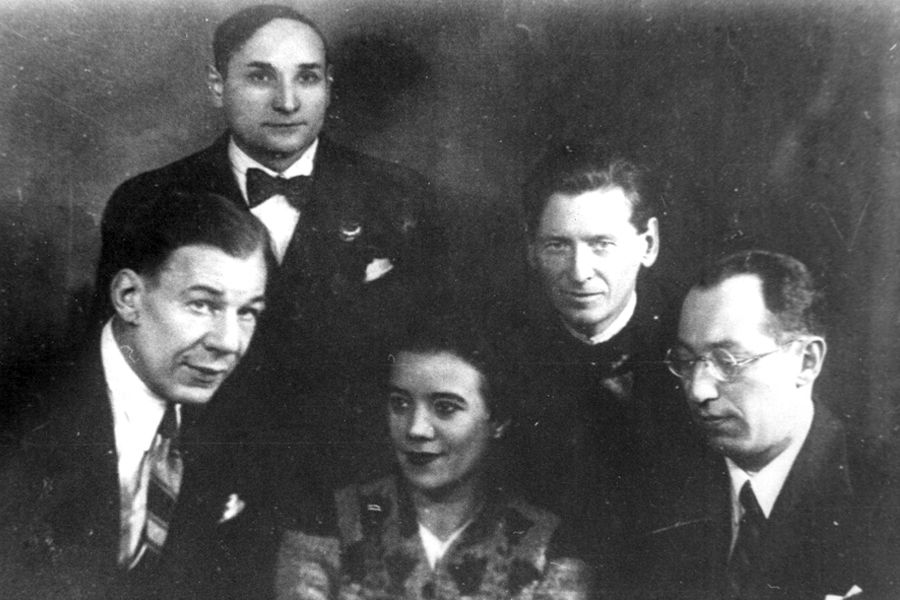
Heroes of the Siege Theatre: an actor of the Pushkin Drama Theatre, Stage Director of The Queen of Spades Yevgeny Studentsov, Director of the Opera Company the singer Ivan Nechaev, ballerina Olga Iordan, designer Georgy Tsorn and conductor Karl Eliasberg
Neither Yevgeny Studentsov nor Georgy Tsorn would live to see VE Day. As early as 1944 on playbills their names were surrounded in black in mourning.

The Maly Opera Theatre. 1944 photograph
“Working at the Comedy Theatre as the company grew became increasingly difficult, both for ballet and in terms of drama,” recalled Ivan Nechaev who was directing the opera company. “The lack of space has had an effect on our work, and the small auditorium could not accommodate even the small number of the public who try to come to the theatre every day. We have raised the matter of restoring the Maly Opera, which is relatively unscathed from shelling. On 3 October 1943 the theatre opened with a concert featuring artistes of the Kirov Opera and Ballet and the Maly Opera and Ballet. The next day we held a dress rehearsal of La traviata there and on the 5th with The Little Humpbacked Horse we began regular work at a theatre which answered all our needs.” *
“With enlarged and newly created sets there were performances of The Queen of Spades and La Esmeralda. <...> The ballet dancers were particularly happy, having at last been given the size of stage they are used to. One thousand three hundred people filled the beautiful and brightly lit auditorium for our performances.” **
* I. Nechaev. Opera during the Siege // Leningrad Theatres during the Great Patriotic War. Moscow–Leningrad: Iskusstvo. 1948. P. 528
** N. Velter. About the Opera House and Me. Leningrad: Sovietsky Kompozitor, 1984. P. 144
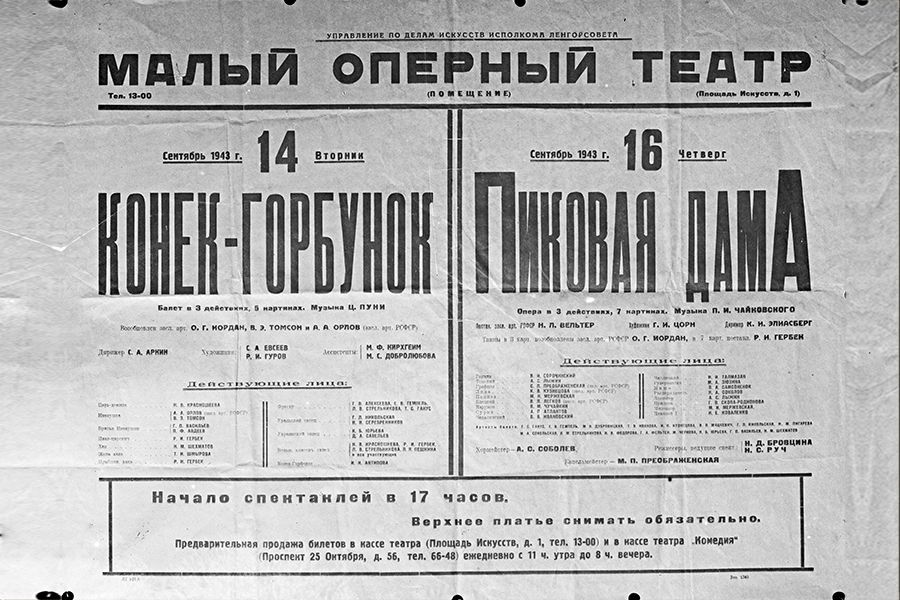
The Little Humpbacked Horse and The Queen of Spades. 1943 playbill
12 September saw a premiere of the ballet The Little Humpbacked Horse at the Maly Opera House. This old production was revived by Olga Iordan and Vladimir Tomson, who in the pre-war years had danced as Ivanushka and the Khan, and so he knew the entire ballet inside out.
“As in previous performances, the lack of men made us drop several scenes and restage certain dances,” Iordan recalled. “Vladimir Tomson staged Russkaya from scratch in a totally unique way” – it was danced by women and just one man. <...> We had to omit the scene of the “Undersea Kingdom” entirely – it demanded a huge number of performers and complex sets. Of course, the children’s dances were also left out. <...> In a word, it wasn’t so much a revival of the ballet as a new and almost independent work, and I was happy when I heard praise directed in my direction. <...> The designer had to show a great deal of inventiveness when staging this demanding production. The sets and costumes were made for him by our theatre’s brilliant artists the sculptor S. A. Yevseyev and R. G. Gurov respectively. In addition to having good taste, he won people over with his exceptional work ethic and inventiveness, which in such conditions was particularly valuable. With the most amazing skill he decorated normal cotton fabrics in gold and silver – they were actually brocade. And so our production looked very elaborate. Before the premiere there unexpectedly arose the question of tunics for the Persian Women. Of course, there was no new tarantella, though at the Kirov theatre there were many old, worn-out tunics. In normal circumstances it would have been easier to unpick them and starch them, but at that time there was no starch in Leningrad whatsoever: it had been eaten back in 1941! R. G. Gurov came up with some kind of stuff that was made with carpentry glue and starched the tunics himself, and they were no worse than they were in peaceful times.”*
*O. Iordan. From diaries // Leningrad Theatres during the Great Patriotic War. Moscow-Leningrad. Iskusstvo. 1948. PP. 510–511

S.A. Yevseyev, set designer of the ballet The Little Humpbacked Horse
“We hung and fixed the sets ourselves. We were managed by Georgy Ivanovich (Tsorn – a designer and the husband of N. Velter – Ed ) <...> We couldn’t fix the stands and so they were often held in position by hand. Naturally there were some tragicomic situations. For example, in the ballet The Little Humpbacked Horse during the performance a stack suddenly collapsed. The sniggering audience fell silent when they realised that the woman lying on the floor had been simply unable to carry the weight of it.” *
*N. Velter. About the Opera House and Me. Leningrad: Sovietsky Kompozitor, 1984. P. 142
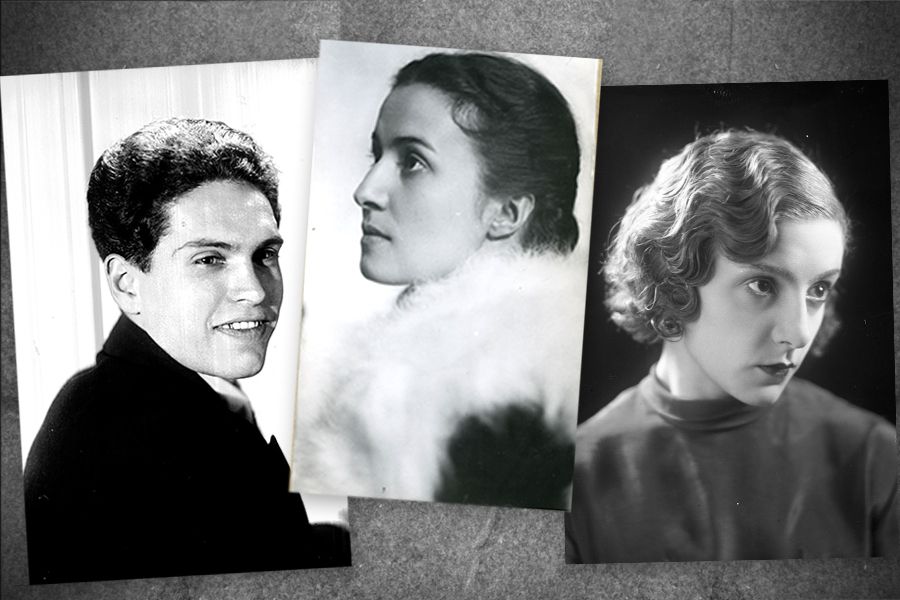
Konstantin Sergeyev. Feya Balabina. Natalia Dudinskaya
In the summer a group of Leningrad performers from Perm took a two-month working trip to Moscow. In August Feya Balabina, Natalia Dudinskaya and Konstantin Sergeyev came to besieged Leningrad. “In Moscow they were extremely cool about our wish to fly,” recalled Konstantin Sergeyev. “It wasn’t without risk. <...> A city damaged in body but bold in spirit. What was the first thing we noticed? Ideal cleanliness. There were few people on the streets but those we saw seemed particularly focussed. There was no panic, even when the city was under attack. Everything went at its own pace.” On 9 August their first concert took place at the Philharmonic. “In the evening everything was unusual: the crammed auditorium, anxiety, stormy applause when the performers appeared,” Sergeyev told the performers who had remained in Perm. “In the auditorium they were waving handkerchiefs. It was not the kind of success we are used to – it was something far greater. Backstage we were approached by a very slender Olga Iordan, Natalia Sakhnovskaya and Robert Gerbek – dancers of the Kirov Ballet who had remained in Leningrad.”*
Nikolai Kondratiev who attended the concert wrote in his diary that “Somehow it was strange to see few people from the forces – typical visitors to theatres, concerts and the cinema during the war. You could see that the audience really knew Dudinskaya, Balabina and Sergeyev. All of the ballet dancers in Leningrad, and not just those in the ballet company at the Comedy Theatre, came to the concert...” O. Model also recorded the vivid memory of that evening in her diary. Recalling that the concert had been interrupted by an air-raid she continued “When we took our seats again after the interruption and there was another bang the audience erupted into friendly laughter – a pure Leningrad reaction.”**
*M. Frangopulo. Years of Peace, Years of War // Konstantin Sergeyev. Anthology of articles. Moscow: Iskusstvo, 1978. P. 169-170
**Quote after: A. Kryukov. Music during the Siege. Chronicle. St Petersburg: Kompozitor, 2002. P. 395

An order for leave for ballet dancer B. V. Shavrov. 24 September 1943

Ballet soloists Alexandra Batoeva and Boris Shavrov performing Russian Dance accompanied by a quartet. 1943
The noticeable retouching of this photograph can be explained – it is a copy of a photograph from the theatre newspaper For Soviet Art from 1943. The Seventh Front-Line Brigade had been on the Volkhov Front for two months and given thirty-nine concerts on the front and seventeen in Leningrad. It included four ballet dancers – Boris Shavrov (a brigadier), his wife Alexandra Blatova, Sara Padve and Alexander Shelepov. There were three singers – Pavel Zhuravlenko, Nina Vasilieva and N.T. Izmailova (opera) and a quartet including Evelina Atanesian (violin), Fyodor Fyodorov (violin), Abram Edelman (viola) and Yevgeny Wolf-Izrael (cello).

People’s Artist of the RSFSR Yevgeny Wolf-Izrael, decorated for merit, after a concert
In the photograph we can see two people who were decorated – the “son of the regiment” with the Order of the Red Banner and the theatre’s oldest musician, cellist Yevgeny Wolf-Izrael (he joined the Mariinsky Theatre back in 1894), who was awarded the Lenin Medal.
“At those times orders were a great rarity,” recalled Mikhail Gherman. “When someone with an order, even a civilian one, walked down the street millionaires would pay their respects; such people had the words ‘Order-Bearer’ written before their names, even in film credits.” * It should be noted that this was mandatory in programmes and in playbills for performances and concerts.
*M. Gherman. Complex Occurrences. St Petersburg: Pechatny Dvor. 2006. P. 24
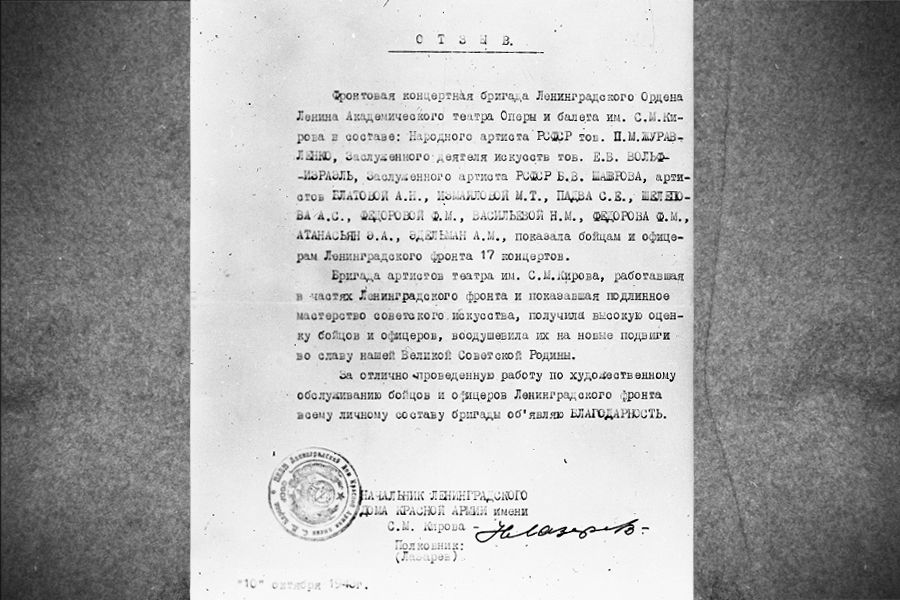
An expression of gratitude to the Front-Line Concert Brigade of the Kirov Opera and Ballet Theatre. 10 October 1943
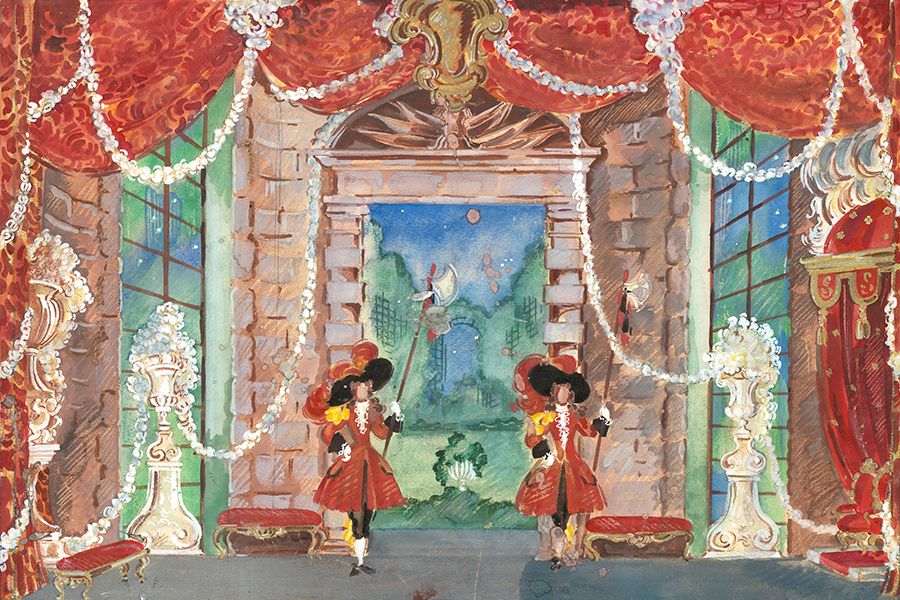
Tatiana Bruni. Set sketch for the ballet The Sleeping Beauty
On 6 October Molotov (Perm) saw the premiere of the revival of The Sleeping Beauty
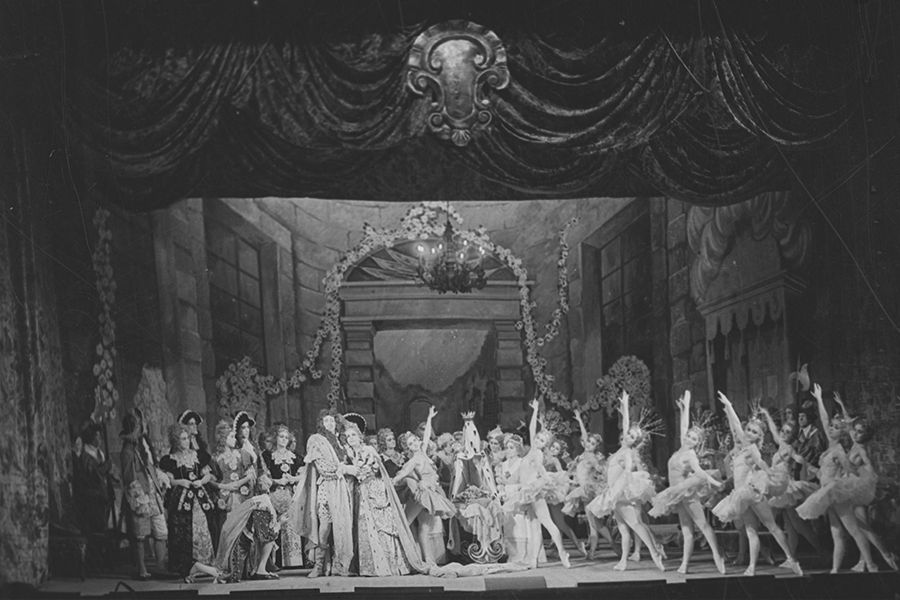
The Sleeping Beauty. Scene from the ballet
Ninel Kurgapkina, a pupil at the Leningrad School of Dance who had been evacuated to the Perm Region, recalled that “We really enjoyed not just rehearsing on a par with the adults but being at the Perm Opera as well... It was warm and cosy there, in the canteen they served tasty sandwiches. We – who had grown unaccustomed to comfort and forgotten the smell of apples and the sugariness of sweets, well, it all seemed like a fairy-tale and untrue. During the interval the audience would tell each other how hard it had been to get tickets: they had come from many kilometres around from different places and had queued all night. We ‘overheard’ these talks. We were unbelievably proud, thinking that this was also a reflection of us: whatever else we were we were ‘almost-artistes’ of the Kirov Theatre!”*
*N. Kurgapkina. Lived next to the heros // Soviet Ballet, 1985, No 3. P. 49


Christmas Eve. Sketches by Fyodor Fedorovsky
1943 concluded with a premiere of Rimsky-Korsakov’s opera Christmas Eve, actually shown on 24 December – Christmas Eve itself – in 1943. The production came on the eve of one century since the birth of Rimsky-Korsakov. The opera was a revelation for both the audience and the theatre’s performers. And it was staged by director Leonid Baratov and conductor Ariy Pazovsky almost “from scratch”. There were no traditions at all, not counting the general traditions of performing the Rimsky-Korsakov repertoire. It is believed that in many scenes the artistic initiative came from Fyodor Fedorovsky – his sets, as always, conceived in the details and the true era with local flavour.
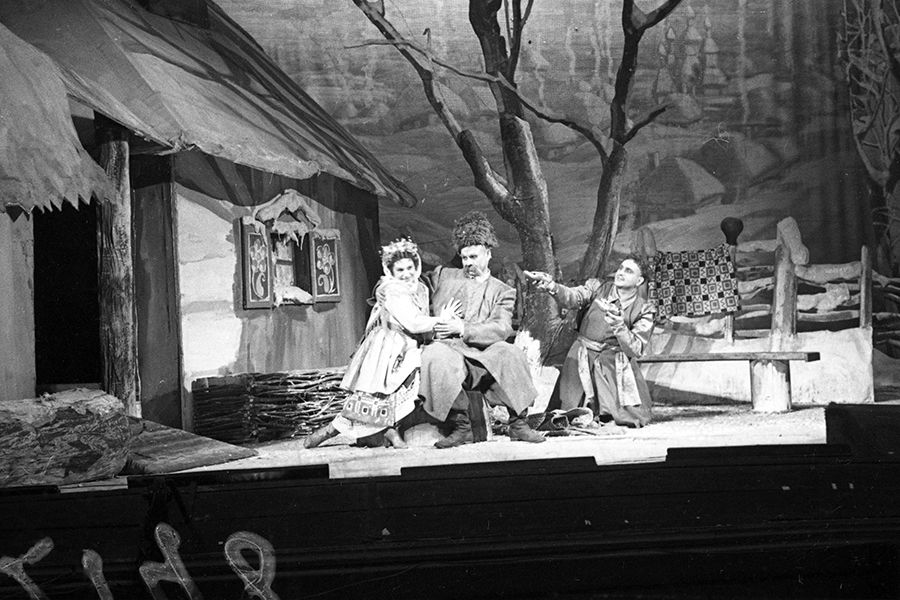
Christmas Eve. Scene from the opera. Olga Kashevarova (Oxana), Ivan Totsky (Chub) and Georgy Nelepp (Vakula)
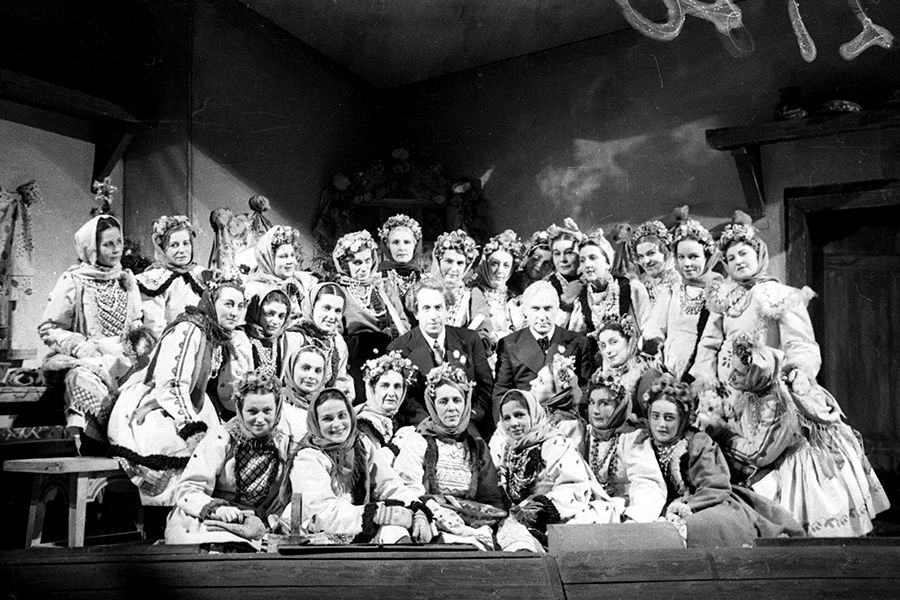
Christmas Eve. Conductor Ariy Pazovsky and stage director Leonid Baratov with performers after the premiere
Artistic Director and Principal Conductor of the theatre from 1936–1943, Perm native Ariy Pazovsky began his conducting career at the Perm Opera. Three of his works for the Kirov Theatre received the highest State award – the Stalin Prize (Ivan Susanin, 1941, The Enchantress, 1942, and Emelian Pugachev, 1943). In February 1943 Pazovsky rehearsed the Perm premiere of Shostakovich’s Seventh Symphony. In January 1944 in line with a decree from the Arts Affairs Committee of the USSR he was appointed Principal Conductor of the Bolshoi Theatre. In April Leonid Baratov was also transferred – he became Principal Stage Director of the Kirov Theatre.
The chronicle features photographs from the Mariinsky Theatre Archive, performers' family collections and the collection of the Central State Archive of Film and Photo Documents of St Petersburg.